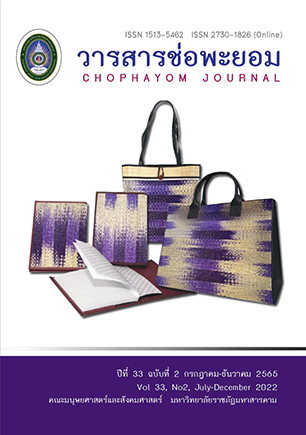The Relationship between Internal Communication Strategy and Gen Y’s Employee Engagement of Bangkok Broadcasting and Television Co., Ltd.
Keywords:
Internal communication strategies, employees’ engagement, Gen Y, Bangkok Broadcasting and Television Co., Ltd.Abstract
The Objectives of This research article are 1) to study the internal communication strategies of Bangkok Broadcasting and Television Co., Ltd. 2) to study employees’ engagement of Bangkok Broadcasting and Television Co., Ltd. and 3) to study the relationship between internal communication strategies and employee engagement of the Bangkok Broadcasting and Television Co., Ltd. Samples were 109 employees who work for Bangkok Broadcasting and Television Co., Ltd. The study used questionnaires as a tool for data collection. The data were analyzed by Pearson’s Product Moment Correlation Coefficient. The results revealed that 1) the respondent agreed that proactive communication is the most important internal communication strategy of Bangkok Broadcasting
and Television Co., Ltd. Due to the effectiveness of BBTV news report, based on accuracy, ethical, creative program, drama, which are accepted in society 2) psychological commitment is an employees’ engagement because it can create pride to tell the others that they are employees of BBTV 3) there is a significant relationship between the internal communication strategies and employees’ engagement of Bangkok Broadcasting and Television Co., Ltd.at 0.01 level. Keywords: internal communication strategies, employees’engagement, Gen Y, Bangkok Broadcasting and Television Co., Ltd.
References
จรัสโฉม ศิริรัตน์. (2558). ปัญหาการติดต่อสื่อสารของบุคลากรในองค์กร: กรณีศึกษา สำนักหอสมุดกลาง มหาวิทยาลัยศรีนครินทรวิโรฒ (รายงานผลการวิจัย). กรุงเทพฯ: โครงการวิจัยสถาบัน มหาวิทยาลัยศรีนครินทรวิโรฒ.
พัชนี เชยจรรยา และคณะ. (2541). แนวคิดหลักนิเทศศาสตร์. กรุงเทพฯ: ข้าวฟ่าง.
วิรัช สงวนวงศ์วาน. (2547). การจัดการและพฤติกรรมองค์การ. พิมพ์ครั้งที่ 2. กรุงเทพฯ : เพียร์สัน เอ็ดดูเคชั่น อินโดไชน่า.
ศิริวรรณ ตันตระวิวัฒน์. (2530). การบริหารงานแบบมีส่วนร่วม: ศึกษาเฉพาะกรณีการไฟฟ้าฝ่ายผลิตแห่งประเทศไทย. (สารนิพนธ์ปริญญามหาบัณฑิต, มหาวิทยาลัยธรรมศาสตร์).
ศุภานัน พุฒตาล. (2560). ปัจจัยที่มีผลต่อแนวโน้มการลาออกของพนักงานมหาวิทยาลัย สายวิชาการ มหาวิทยาลัยเทคโนโลยีราชมงคลธัญบุรี. (รายงานการวิจัย). ปทุมธานี: มหาวิทยาลัยเทคโนโลยีราชมงคลธัญบุรี.
อาริญา เฮงทวีทรัพย์สิริ. (2558). ความผูกพันต่อองค์การ บุคลิกภาพห้าองค์ประกอบและความสุขในการทำงานของพยาบาล โดยมีพฤติกรรมการเป็นสมาชิกที่ดีขององค์การเป็นตัวแปรสื่อ: กรณีศึกษาโรงพยาบาลมหาวิทยาลัยในกำกับของรัฐแห่งหนึ่ง. (วิทยานิพนธ์ปริญญามหาบัณฑิต, มหาวิทยาลัยธรรมศาสตร์).
อัจฉรา สุขกลั่น, เกษราภรณ์ สุตตาพงศ์ และ ณัฐยา ยวงใย. (2561). กลยุทธ์การสื่อสารองค์กรเพื่อสร้างวัฒนธรรมองค์กรแข็งแกร่ง. วารสารการจัดการสมัยใหม่, 16(1), 75-82.
Allen, N. J., & Meyer, J. P. (1990). The measurement and antecedents of affective, continuance and normative commitment to the organization. Journal of Occupational Psychology, 63(1), 1–18.
Becker, H.S. (1960). Notes on Concept of Commitment. American:Journal of Sociallogy.
Chester, B. I. (1968). The Function of the Executive. Cambridge Mass:Harvard University Press.
Kotter, J.P. (1996). Leading Change. Boston : Harvard Business Review School Book.
Mowday,R.T.,Steers, R.M., and Porter, L.M. (1979). The measurement of organizational commitment. Journal of Vocational Behavior, 14, 224-247.
Downloads
Published
How to Cite
Issue
Section
License
Copyright (c) 2022 Chophayom Journal

This work is licensed under a Creative Commons Attribution-NonCommercial-NoDerivatives 4.0 International License.






